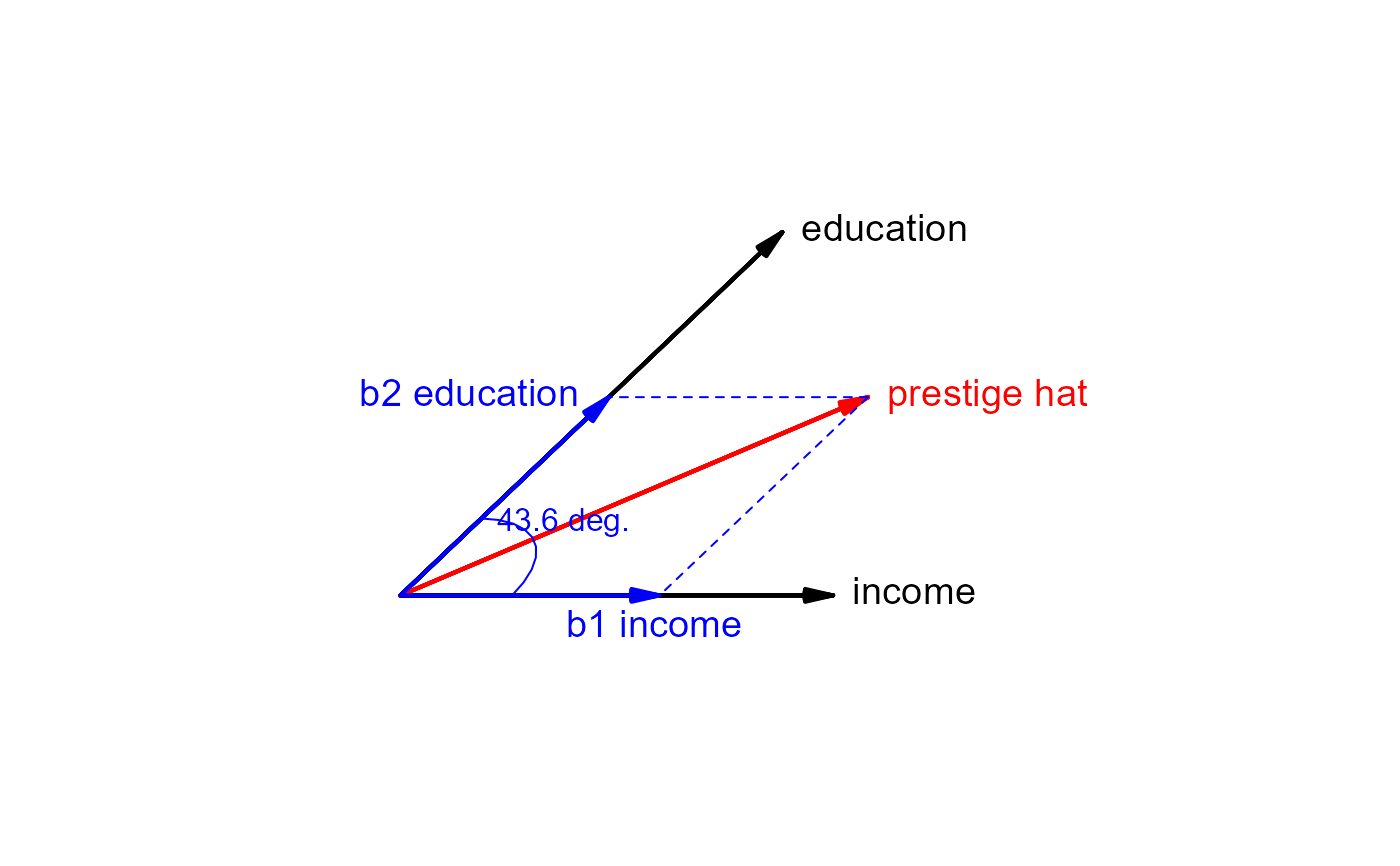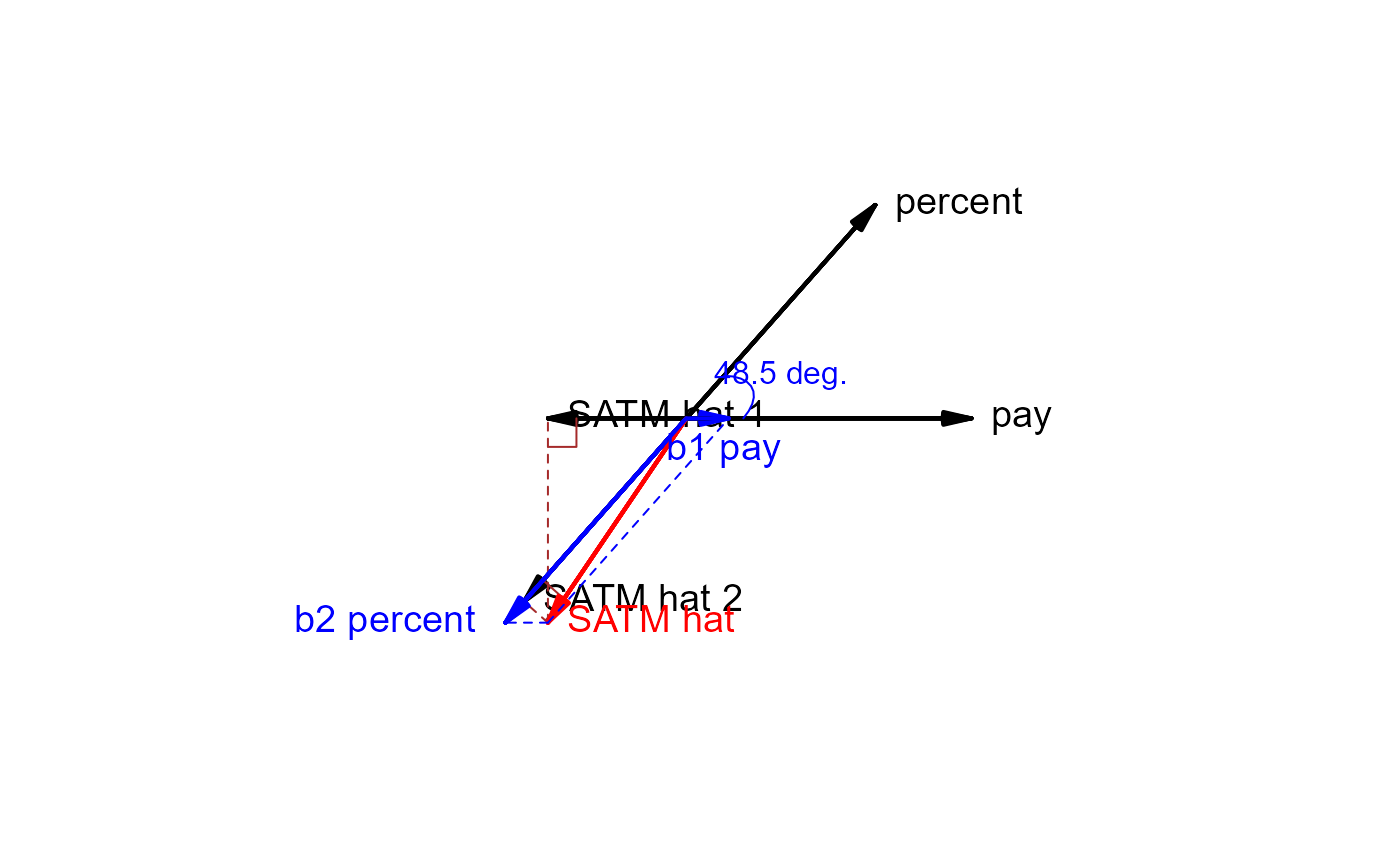The plot method for regvec3d objects uses the low-level graphics tools in this package to draw 3D and 3D
vector diagrams reflecting the partial and marginal
relations of y to x1 and x2 in a bivariate multiple linear regression model,
lm(y ~ x1 + x2).
The summary method prints the vectors and their vector lengths, followed by the summary
for the model.
Usage
# S3 method for class 'regvec3d'
plot(
x,
y,
dimension = 3,
col = c("black", "red", "blue", "brown", "lightgray"),
col.plane = "gray",
cex.lab = 1.2,
show.base = 2,
show.marginal = FALSE,
show.hplane = TRUE,
show.angles = TRUE,
error.sphere = c("none", "e", "y.hat"),
scale.error.sphere = x$scale,
level.error.sphere = 0.95,
grid = FALSE,
add = FALSE,
...
)
# S3 method for class 'regvec3d'
summary(object, ...)
# S3 method for class 'regvec3d'
print(x, ...)Arguments
- x
A “regvec3d” object
- y
Ignored; only included for compatibility with the S3 generic
- dimension
Number of dimensions to plot:
3(default) or2- col
A vector of 5 colors.
col[1]is used for the y and residual (e) vectors, and for x1 and x2;col[2]is used for the vectorsy -> yhatandy -> e;col[3]is used for the vectorsyhat -> b1andyhat -> b2;- col.plane
Color of the base plane in a 3D plot or axes in a 2D plot
- cex.lab
character expansion applied to vector labels. May be a number or numeric vector corresponding to the the rows of
X, recycled as necessary.- show.base
If
show.base > 0, draws the base plane in a 3D plot; ifshow.base > 1, the plane is drawn thicker- show.marginal
If
TRUEalso draws lines showing the marginal relations ofyonx1and onx2- show.hplane
If
TRUE, draws the plane defined byy,yhatand the origin in the 3D- show.angles
If
TRUE, draw and label the angle between thex1andx2and betweenyandyhat, corresponding respectively to the correlation between the xs and the multiple correlation- error.sphere
Plot a sphere (or in 2D, a circle) of radius proportional to the length of the residual vector, centered either at the origin (
"e") or at the fitted-values vector ("y.hat"; the default is"none".)- scale.error.sphere
Whether to scale the error sphere if
error.sphere="y.hat"; defaults toTRUEif the vectors representing the variables are scaled, in which case the oblique projections of the error spheres can represent confidence intervals for the coefficients; otherwise defaults toFALSE.- level.error.sphere
The confidence level for the error sphere, applied if
scale.error.sphere=TRUE.- grid
If
TRUE, draws a light grid on the base plane- add
If
TRUE, add to the current plot; otherwise start a new rgl or plot window- ...
Parameters passed down to functions [unused now]
- object
A
regvec3dobject for thesummarymethod
Details
A 3D diagram shows the vector y and the plane formed by the predictors,
x1 and x2, where all variables are represented in deviation form, so that
the intercept need not be included.
A 2D diagram, using the first two columns of the result, can be used to show the projection
of the space in the x1, x2 plane.
The drawing functions vectors and vectors3d used by the plot.regvec3d method only work
reasonably well if the variables are shown on commensurate scales, i.e., with
either scale=TRUE or normalize=TRUE.
References
Fox, J. (2016). Applied Regression Analysis and Generalized Linear Models, 3rd ed., Sage, Chapter 10.
Examples
if (require(carData)) {
data("Duncan", package="carData")
dunc.reg <- regvec3d(prestige ~ income + education, data=Duncan)
plot(dunc.reg)
plot(dunc.reg, dimension=2)
plot(dunc.reg, error.sphere="e")
summary(dunc.reg)
# Example showing Simpson's paradox
data("States", package="carData")
states.vec <- regvec3d(SATM ~ pay + percent, data=States, scale=TRUE)
plot(states.vec, show.marginal=TRUE)
plot(states.vec, show.marginal=TRUE, dimension=2)
summary(states.vec)
}
#> Loading required package: carData
 #> x y z length
#> income 0.7754622 0.0000000 0.0000000 0.7754622
#> education 0.6842863 0.6509930 0.0000000 0.9444785
#> prestige 0.8378014 0.3553340 0.4145197 1.0000000
#> residuals 0.0000000 0.0000000 0.4145197 0.4145197
#> prestige hat 0.8378014 0.3553340 0.0000000 0.9100403
#> b1 income 0.4642947 0.0000000 0.0000000 0.4642947
#> b2 education 0.3735067 0.3553340 0.0000000 0.5155284
#> prestige hat 1 0.8378014 0.0000000 0.0000000 0.8378014
#> prestige hat 2 0.6172234 0.5871929 0.0000000 0.8519156
#>
#> Call:
#> lm(formula = formula, data = Data)
#>
#> Residuals:
#> Min 1Q Median 3Q Max
#> -29.538 -6.417 0.655 6.605 34.641
#>
#> Coefficients:
#> Estimate Std. Error t value Pr(>|t|)
#> (Intercept) -6.06466 4.27194 -1.420 0.163
#> income. 0.59873 0.11967 5.003 1.05e-05 ***
#> education. 0.54583 0.09825 5.555 1.73e-06 ***
#> ---
#> Signif. codes: 0 '***' 0.001 '**' 0.01 '*' 0.05 '.' 0.1 ' ' 1
#>
#> Residual standard error: 13.37 on 42 degrees of freedom
#> Multiple R-squared: 0.8282, Adjusted R-squared: 0.82
#> F-statistic: 101.2 on 2 and 42 DF, p-value: < 2.2e-16
#>
#> x y z length
#> income 0.7754622 0.0000000 0.0000000 0.7754622
#> education 0.6842863 0.6509930 0.0000000 0.9444785
#> prestige 0.8378014 0.3553340 0.4145197 1.0000000
#> residuals 0.0000000 0.0000000 0.4145197 0.4145197
#> prestige hat 0.8378014 0.3553340 0.0000000 0.9100403
#> b1 income 0.4642947 0.0000000 0.0000000 0.4642947
#> b2 education 0.3735067 0.3553340 0.0000000 0.5155284
#> prestige hat 1 0.8378014 0.0000000 0.0000000 0.8378014
#> prestige hat 2 0.6172234 0.5871929 0.0000000 0.8519156
#>
#> Call:
#> lm(formula = formula, data = Data)
#>
#> Residuals:
#> Min 1Q Median 3Q Max
#> -29.538 -6.417 0.655 6.605 34.641
#>
#> Coefficients:
#> Estimate Std. Error t value Pr(>|t|)
#> (Intercept) -6.06466 4.27194 -1.420 0.163
#> income. 0.59873 0.11967 5.003 1.05e-05 ***
#> education. 0.54583 0.09825 5.555 1.73e-06 ***
#> ---
#> Signif. codes: 0 '***' 0.001 '**' 0.01 '*' 0.05 '.' 0.1 ' ' 1
#>
#> Residual standard error: 13.37 on 42 degrees of freedom
#> Multiple R-squared: 0.8282, Adjusted R-squared: 0.82
#> F-statistic: 101.2 on 2 and 42 DF, p-value: < 2.2e-16
#>
 #> x y z length
#> pay 1.0000000 0.0000000 0.000000 1.0000000
#> percent 0.6630098 0.7486108 0.000000 1.0000000
#> SATM -0.4853306 -0.7164880 0.501098 1.0000000
#> residuals 0.0000000 0.0000000 0.501098 0.5010980
#> SATM hat -0.4853306 -0.7164880 0.000000 0.8653905
#> b1 pay 0.1492295 0.0000000 0.000000 0.1492295
#> b2 percent -0.6345601 -0.7164880 0.000000 0.9570901
#> SATM hat 1 -0.4853306 0.0000000 0.000000 0.4853306
#> SATM hat 2 -0.5689615 -0.6424199 0.000000 0.8581495
#>
#> Call:
#> lm(formula = formula, data = Data)
#>
#> Residuals:
#> Min 1Q Median 3Q Max
#> -29.697 -13.788 0.701 9.988 42.961
#>
#> Coefficients:
#> Estimate Std. Error t value Pr(>|t|)
#> (Intercept) 513.6990 16.9174 30.365 < 2e-16 ***
#> pay. 0.9718 0.6292 1.545 0.129
#> percent. -1.3743 0.1387 -9.906 3.45e-13 ***
#> ---
#> Signif. codes: 0 '***' 0.001 '**' 0.01 '*' 0.05 '.' 0.1 ' ' 1
#>
#> Residual standard error: 17.68 on 48 degrees of freedom
#> Multiple R-squared: 0.7489, Adjusted R-squared: 0.7384
#> F-statistic: 71.58 on 2 and 48 DF, p-value: 3.947e-15
#>
#> x y z length
#> pay 1.0000000 0.0000000 0.000000 1.0000000
#> percent 0.6630098 0.7486108 0.000000 1.0000000
#> SATM -0.4853306 -0.7164880 0.501098 1.0000000
#> residuals 0.0000000 0.0000000 0.501098 0.5010980
#> SATM hat -0.4853306 -0.7164880 0.000000 0.8653905
#> b1 pay 0.1492295 0.0000000 0.000000 0.1492295
#> b2 percent -0.6345601 -0.7164880 0.000000 0.9570901
#> SATM hat 1 -0.4853306 0.0000000 0.000000 0.4853306
#> SATM hat 2 -0.5689615 -0.6424199 0.000000 0.8581495
#>
#> Call:
#> lm(formula = formula, data = Data)
#>
#> Residuals:
#> Min 1Q Median 3Q Max
#> -29.697 -13.788 0.701 9.988 42.961
#>
#> Coefficients:
#> Estimate Std. Error t value Pr(>|t|)
#> (Intercept) 513.6990 16.9174 30.365 < 2e-16 ***
#> pay. 0.9718 0.6292 1.545 0.129
#> percent. -1.3743 0.1387 -9.906 3.45e-13 ***
#> ---
#> Signif. codes: 0 '***' 0.001 '**' 0.01 '*' 0.05 '.' 0.1 ' ' 1
#>
#> Residual standard error: 17.68 on 48 degrees of freedom
#> Multiple R-squared: 0.7489, Adjusted R-squared: 0.7384
#> F-statistic: 71.58 on 2 and 48 DF, p-value: 3.947e-15
#>
